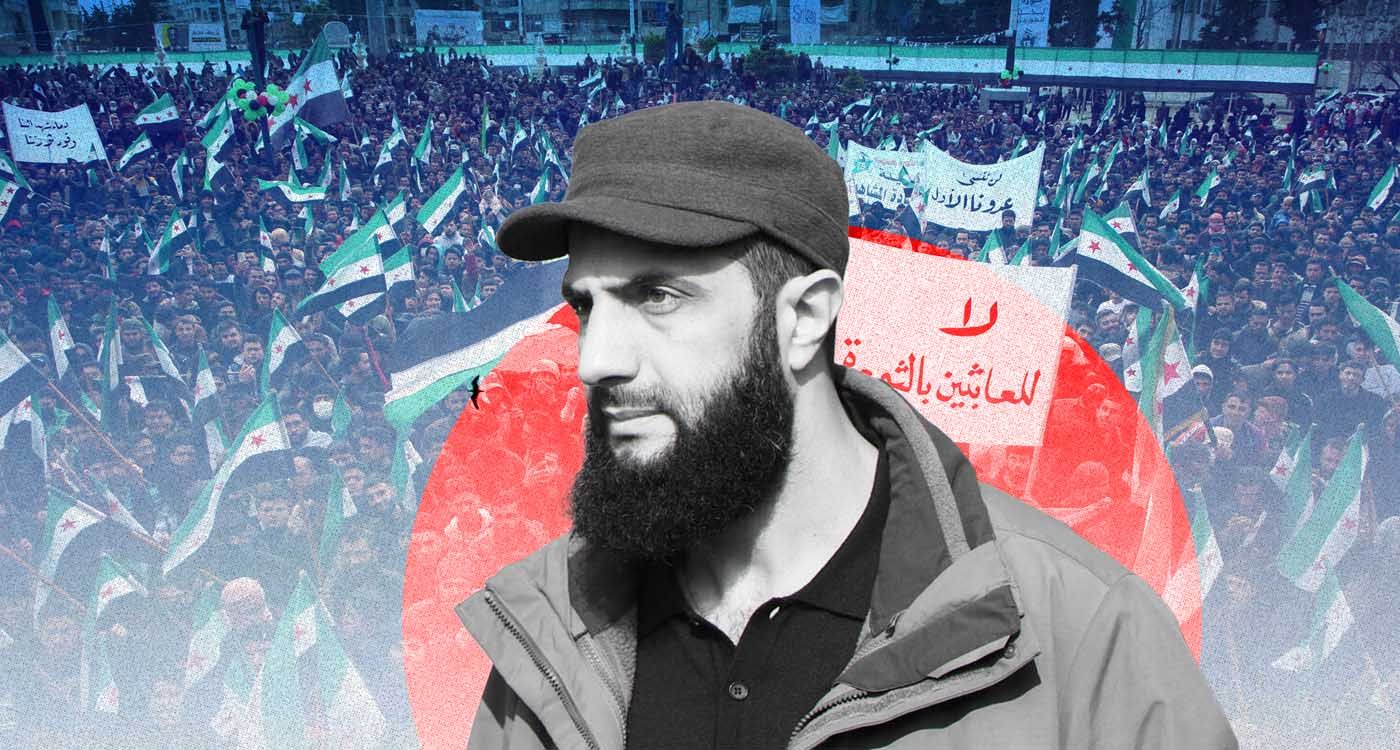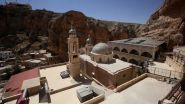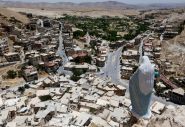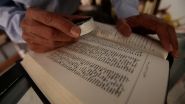- Home
- Highlights
- HTS: Repression Driving the Protests

©This is Beirut
Starting in February 2024, a wave of protests has swept through the cities of Idlib, Binnish and Sarmada, quickly spreading across much of Syria's northwestern province. The demonstrations are a direct response to the repressive governance of Hay’at Tahrir al-Sham (HTS), compounded by worsening economic conditions and a collapse in basic services. Grievances fueling the unrest include the persistent lack of humanitarian aid in the aftermath of the 2023 earthquake, soaring taxes, widespread unemployment and the rapid devaluation of the Turkish lira.
A Long-Standing Anger
Although widespread anger did not fully erupt until 2024, the protests in Idlib, Binnish and Sarmada reflect a long-simmering resentment that has been building for years.
As early as 2019 and 2020, signs of discontent with Hay’at Tahrir al-Sham’s (HTS) rule had already begun to surface across the region. A 2020 report by the Washington Institute noted that several villages had voiced frustration over HTS’ increasingly authoritarian practices. In Hazano, a northern Idlib village, residents launched a social media campaign titled “Down with the New Hazano Council,” accusing the HTS-imposed local authority of lacking legitimacy and failing to represent community interests.
In November 2019, residents of Kafr Takharim protested against the collection of zakat on their olive harvests, denouncing the tax as excessive. When locals expelled HTS members from the area in response, the group quickly retaliated by deploying forces to crush the resistance.
Even before that, the city of Kafr Nabl — long known for its defiant stance against the Assad regime — saw a chilling incident that many linked to HTS. In November 2018, prominent activist and founder of Radio Fresh FM, Raed Fares, was assassinated alongside his colleague Hamoud Junaid. Fares had been an outspoken critic of HTS, and his death sent shockwaves through activist networks.
Ahmad Jallal, the creator of Kafr Nabl’s famous protest banners, fled Syria shortly after. In a 2019 interview with Syria Untold, he recalled, “After accusing Jabhat al-Nusra [HTS’ predecessor] of killing Raed and Hamoud, I was threatened with death and arrest — not by official Jabhat al-Nusra sources, but by affiliates within the organization.”
HTS’ grip on Idlib has long faced resistance, not only from residents but also from rival Islamist groups. One such group, Hizb ut-Tahrir, which advocates for the re-establishment of the Islamic caliphate through nonviolent means, became a target in 2023 when HTS began arresting its members. The crackdown sparked protests from families and supporters, though any momentum for broader resistance was swiftly stifled.
“HTS has consistently relied on harsh methods to suppress protests and civilian unrest, with arbitrary arrests being a standard response,” said Tammy Palacios, a counterterrorism analyst at the New Lines Institute. She added, “Al-Jolani and HTS have always been driven by an insatiable thirst for control.”
A report published in October 2024 by Syrians for Truth and Justice (STJ) detailed how HTS continues to suppress dissent using a combination of intimidation and force. According to the report, the group regularly arrests demonstrators without judicial warrants, targets online critics, and, in cases of large-scale protest, resorts to live ammunition to disperse crowds.
Internal Purge
HTS also launched a wide-ranging campaign of internal arrests during the second quarter of 2023, accusing hundreds of individuals of “spying for foreign countries” and “misusing communications.” Among those detained was Abu Maria al-Qahtani, a former Iraqi leader within HTS who had been responsible for managing external relations.
A native of Mosul, Qahtani was highly respected within the group. He co-founded Jabhat al-Nusra with Abu Mohammad al-Jolani and played a crucial role in the formation of HTS, which was later led by al-Jolani. Qahtani was also instrumental in building alliances with tribes in northern Syria, coming from a prominent tribal background himself. After six months in prison, he was released in March 2024, along with other detainees.
“These arrests were not driven by ideological differences, but by al-Sharaa’s obsession with removing those who held too much influence within HTS,” says Thomas Pierret, a researcher at the French National Centre for Scientific Research (CNRS) and an expert on Syria, in an interview with This is Beirut. “Abu Maria al-Qahtani was extremely influential, commanding forces in Deir Ezzor with substantial wealth and strong tribal connections. However, he was also a pragmatist — he was the first to advocate for combating ISIS and severing ties with al-Qaeda. Al-Sharaa simply saw him as a threat due to his growing power.”
Having achieved his goals but also facing increasing public pressure, al-Jolani pledged to identify those responsible for human rights violations and torture against prisoners. After their release, numerous accounts of torture began circulating, prompting him to promise accountability. However, in April 2024, a suicide bomber killed Abu Maria al-Qahtani, and the blame was initially placed on ISIS. Despite this, many of al-Qahtani's supporters believed HTS was the true perpetrator.
Internal challenges continued with the defection of Abu Ahmad Zakour, another key HTS figure with deep tribal ties. Zakour had facilitated HTS’ expansion into Afrin and worked to undermine Syrian National Army (SNA) factions by infiltrating their ranks. His defection to SNA-held, Turkish-backed territory marked a major blow to HTS’ internal cohesion. Once in opposition territory, Zakour became a vocal critic of HTS and its leader, al-Jolani, publicly denouncing their leadership and methods.
An Unprecedented Protest Movement
By late February 2024, protests erupted in Idlib and rapidly spread to Binnish, Sarmada and across the wider region. Demonstrators demanded an end to Hay’at Tahrir al-Sham’s (HTS) rule, the removal of its leader Abu Mohammad al-Jolani, sweeping political reforms and the release of political detainees.
“At this point, there was a growing sentiment that al-Sharaa was consolidating his power, focusing more on managing a Sunni microstate than on challenging the regime,” explained Thomas Pierret.
Abu Obeida was a fighter in Jaysh al-Ahrar (The Army of the Free), a faction within the Syrian National Army (SNA). According to Enab Baladi, he was arrested in April 2023 after resisting HTS entry into his village. When HTS refused to return his body, his family insisted on knowing the location of his grave. The funeral, attended by an outraged crowd, became a flashpoint, catalyzing regular Friday protests throughout the province.
In an interview with This is Beirut, a Syrian expert on HTS, speaking anonymously, stated, “The public turned vehemently against the security services and al-Jolani, who allowed such acts of humiliation and torture, as reported by the prisoners released from custody.”
Protesters interviewed by Syrians for Truth and Justice (STJ) echoed these frustrations, explaining that HTS’ repressive tactics and tight control over society were the main reasons they took to the streets, despite the fear of arrest. The protesters also voiced their anger over excessive taxes and the uneven distribution of resources.
“What stands out is the enduring nature of this movement, with protests spreading across the Idlib region and gaining support from prominent civil society figures, including notable individuals from religious and tribal communities,” noted Thomas Pierret. “This is a movement that has genuinely unsettled al-Sharaa.”
To quell the anger, HTS adopted a more conciliatory approach, releasing several hundred detainees and promising to investigate and hold accountable those responsible for acts of violence and torture. However, these efforts proved insufficient to pacify the movement.
Armed Repression: The Ultimate Solution
Faced with the unrelenting protests, HTS shifted its strategy to forceful repression. On May 14, a demonstration in Idlib was violently suppressed by members of the General Security Department of the Syrian Salvation Government (SSG). The next day, the SSG Minister of the Interior, Mohammad Abdel Rahman, threatened protesters, warning that any attempt to destabilize the liberated areas would be met with an iron fist. Al-Jolani, meanwhile, argued that “the protests had strayed from their original intent,” and that the situation had “exceeded its natural limits.”
In the following weeks, HTS erected checkpoints across the region and launched a sweeping campaign of arrests. Activists were accused of inciting violence and “promoting the use of weapons and explosive belts.” Once detained, many were tortured and coerced into signing pledges not to participate in future protests.
According to an August 2024 report by the Independent International Commission of Inquiry on the Syrian Arab Republic (affiliated with the UN), many individuals — including pregnant women and children as young as seven — were arrested for criticizing HTS, participating in protests or seeking justice through the courts of the “Salvation Government.” The report also highlighted the extensive use of torture in HTS prisons, with methods including the “dulab” (where a prisoner is forced into a car tire and beaten), “shabeh” (a prisoner suspended by their wrists) and brutal beatings with pipes, cables and sticks. Prisoners typically had no access to legal representation or fair trials.
Numerous executions were also reported, with the families of the victims often denied access to the bodies. The Commission of Inquiry concluded that “these acts could be considered war crimes” and stated that “there are reasonable grounds to believe that members of HTS may have committed acts that amount to enforced disappearances.”
The Decline of the Protest Movement
As the crackdown intensified, the protest movement began to lose momentum. “A few months ago, rumors spread about a potential attack on the regime, suggesting that internal divisions were not timely,” explained the HTS expert. “At that moment, many people joined the protests, knowing they were eagerly awaiting an opportunity to launch an attack on the regime and reclaim their villages.”
Although the core demands for reform remained, the changing national context — particularly with the fall of the regime and the capture of Damascus — shifted the protesters' priorities. Many residents across Idlib and beyond are choosing to observe how the national situation evolves before deciding whether to return to the streets.
Read more





Comments